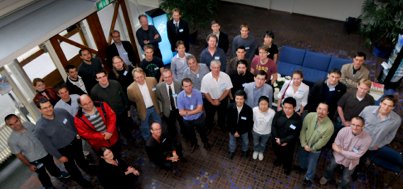Event: 26 May 2011: Discontinuous Galerkin Methods in Computational Electro- magnetics: A Workshop on Recent developments in Theory and Applications
Discontinuous Galerkin Methods in Computational Electro magnetics: A Workshop on Recent developments In Theory and Applications
Date: May 26, 2011
Location: National Aerospace Laboratory (NLR) - Amsterdam
Audience: We aim to address PhD students and experienced computational electromagnetics modelers, that are new to discontinuous Galerkin methods and have them interact with DG developers.
Subject: Discontinuous Galerkin methods have been developed only relatively recently. They combine three key properties that make these very attractive for the discretisation of either hyperbolic or elliptic partial differential equations in comparison with e.g. ‘classic’ finite element methods:
· Efficient combined h-p refinement
· Straightforward parallelization and porting to GPU architecture
· Accurate representation of field discontinuities and singularities
Discontinuous Galerkin methods have general applicability, but this workshop focuses on the application for electromagnetic simulations. Especially the multi-scale character of large-scale high frequency scattering computations brings out the advantages offered by these methods.
We would like to bring forward the potential of this technology in an environment still dominated by the application of ‘classic’ finite element and boundary integral methods.
Organization: Dr.ir. Duncan R. van der Heul (TUD), Dr. J.K. Ryan (TUD), Dr. H. van der Ven (NLR)
Report
On 26 May 3TU.AMI and the National Aerospace Laboratory NLR co-organized a 1-day workshop on the theory and applications of discontinuous Galerkin methods for application in high frequency electromagnetic applications. The aim of the workshop was threefold:
- Introduce interested newcomers to this very interesting field of research.
- Show the strength of this method for the application to large scale electromagnetic simulations.
- Exchange new ideas, start new and extend existing cooperation between industry and academia in the field of discontinuous Galerkin methods.
We were very privileged to find three leading experts, both from academia and industry, in the field willing to give a talk in their specific expertise. Although primarily focused on Dutch researchers and engineers, nearly forty people from all over Europe have attended the event.
The morning session was opened by Ir. Koen de Cock the head of the Flight Physics and Loads Department of the NLR, representing the host of the workshop. Prof. Jan Hesthaven (Brown University, US) started of the scientific part of the program by giving a very accessible tutorial to the discontinuous Galerkin Method.
Next, Prof. Jaap vd Vegt (Twente University) and Dr. Xavier Ferrieres (ONERA, Toulouse) have presented two very interesting talks on recent developments in the application of discontinuous Galerkin methods specifically for the Maxwell equations.
In the afternoon four PhD students from France and The Netherlands presented their research on discontinuous Galerkin and mimetic discretisations and solution algorithms for the resulting linear systems. The first part of the afternoon session was concluded by a short contributed presentation of Dr. Gjonaj (Technische Universität Darmstadt).
The scientific program was completed by Prof. Hesthaven in a second talk, were he addressed more advanced topics regarding the application of discontinuous Galerkin for the Maxwell equations, and especially how the use of Graphical Processing Units (GPU's) can reduce the computational time.
The workshop was concluded in the adjacent NLR Pub.
We would like to thank our sponsors for their generous support, that made the organization of this event possible:3TU.AMI , The Netherlands Organization for Scientific Research (NWO), The Delft center for Computational Science and Engineering (DCSE), The National Aerospace Laboratory NLR
Specifically, we would like to thank the NLR event manager Mrs. Hennie Heeremans and other NLR staff for their help and support.

Date: 26 May 2011



